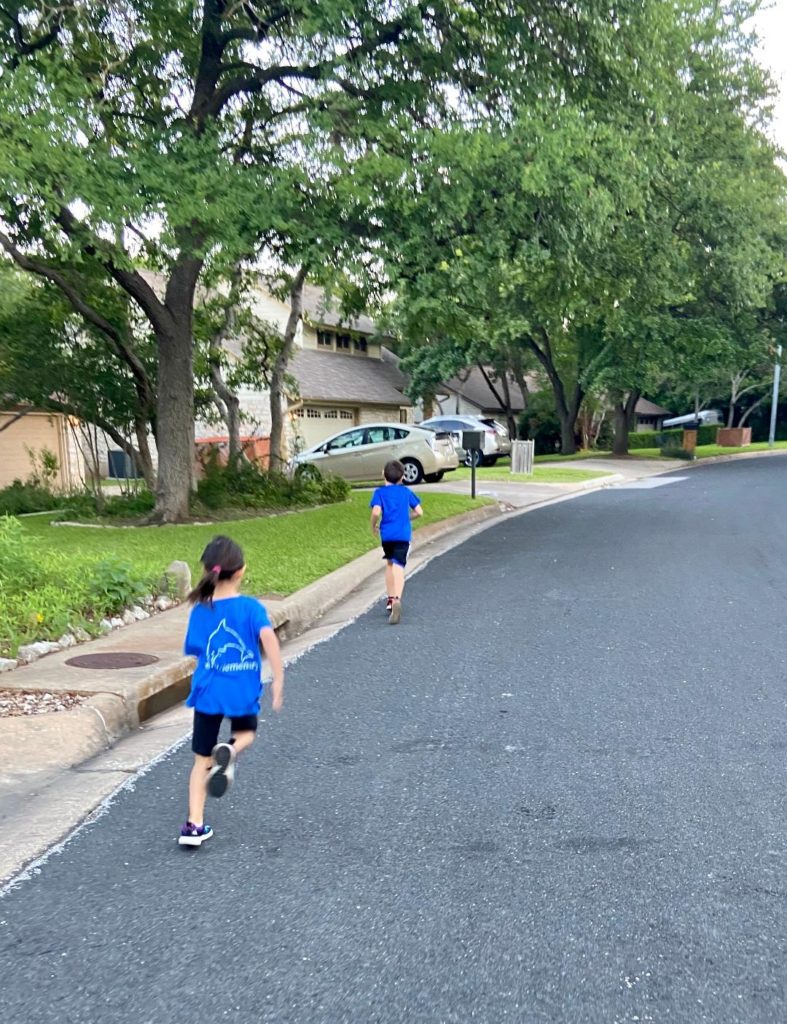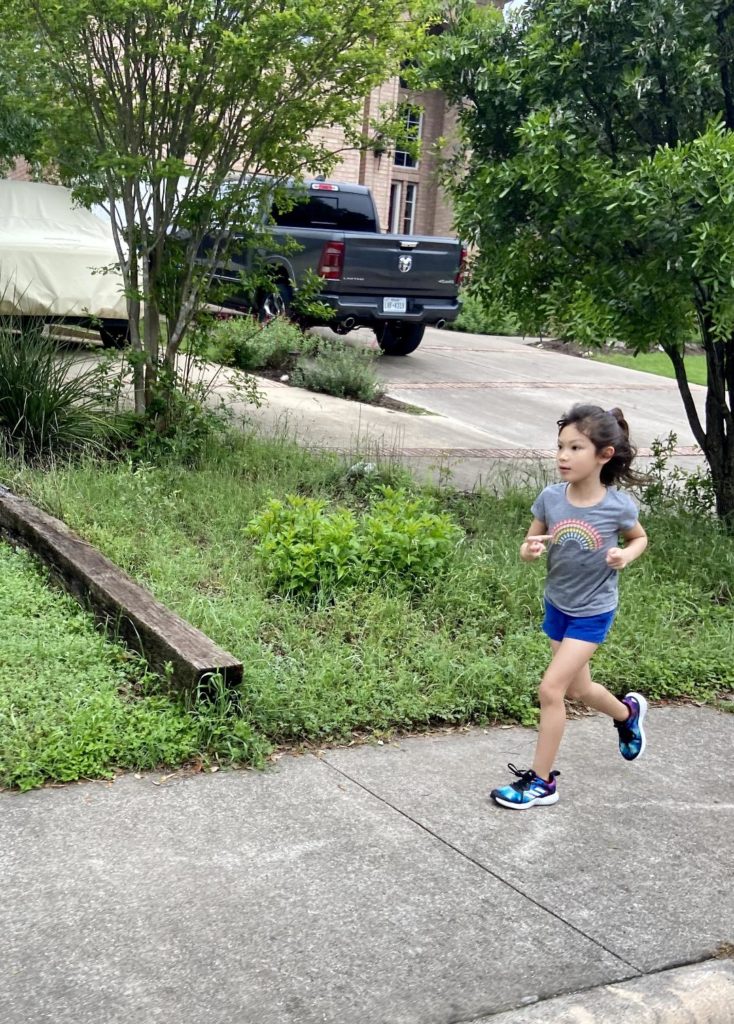Christina Edwards is a longtime runner and working mom of two. Since Stay at Home began in mid-March in the Austin area due to the global COVID-19 pandemic, Edwards and her husband have focused on balancing the family’s daily workouts with their children’s online schooling, all while continuing to work full-time from home.
The Edwards children—West, who is eight years old and in second grade, and Wynne, who is six and in kindergarten—attend Davis Elementary in northwest Austin. When school was still in session, they ran with the Davis Marathon Kids run club, and they have kept their running habits going since Stay at Home began.
“My kids are running five days a week,” says Edwards. “I tell them they need to take at least two days off, so they’ve been averaging about 10 miles a week.” West is largely self-motivated, thanks to his innate love of running. Wynne started running mainly because big brother was doing it. “My daughter is very stubborn,” Edwards says, “and wanted to prove she could hang with us for two to three miles.”
Parents Can Set a Good Example
“We never pushed our kids to run,” Edwards says, “but they saw us running and biking, as I do triathlons and have run a couple of marathons since West was born. He is obsessed with Usain Bolt, even though he considers himself an endurance runner.”
Earlier in elementary school, West kept asking his parents if he could run more. He even wanted to join a running club, says Edwards, “but we were not sure if it was just a fleeting thing. After begging for a year, and doing a lot of research—we found that a lot of running clubs that cater to kids are either very serious or too far of a commute with less than ideal hours for two working parents—we reached out to Austin Youth Fitness about starting a run club at Davis. Our PE Teacher and the AYF founder, Larry Chauvin, were amenable, and we got a run club started.”
They needed a minimum of 10 kids to make it happen. Fortunately, West wasn’t the only kid at school who was excited to join a run club. “There was plenty of interest, and I think the first run that started this past winter was at capacity with 26 kids!”
Building Up Mileage, One at a Time
Soon, West was covering two to three miles a day at recess with a couple of friends. “They use a scan card to run at recess and track the laps,” says Edward. At times, West has been at the top of the Davis mileage board, while at other times he’s fallen to fifth or sixth place. Now that the school has closed, she says, West’s PE teacher is allowing him to track his mileage from home. “He went back to first place in terms of mileage completed during this homeschool period.”
Even during the first couple of weeks of Stay at Home, when the Edwards family hadn’t yet started tracking the children’s miles, West was running almost every day. “His goal when he started was nine marathons, because that was the most the top runner ran last year at Davis.” The family started tracking mileage sometime during the second or third week of distance-learning, and in the weeks since, West has exceeded his own goal. “In total, he has run 11 marathons,” reports his mom—and counting.
Physical Activity Is Important, Especially During Trying Times
“Since we started staying at home,” Edwards says, “I have encouraged the kids to stay active because it is healthy and burns some energy, as both kids are very high energy. My daughter has also learned how to ride a bike, so that has been really fun. The kids tend to run early in the morning, around 6:30 or 7 a.m., after my husband and I get our workouts in. Then we’ll bike during the day, and if it’s a nice evening, we’ll go for a neighborhood bike or scooter ride, or walk our dog, Kona. It’s a great way to get out of the house and move a bit, since we obviously are not participating in our normal activities as we did pre-pandemic.”
Staying active has been especially important since Stay at Home began, Edwards says, “as it helps us maintain a routine that the kids were already used to before, since they would run regularly at school and on the weekends. Now, it gives us fresh air and a way to get out of the house regularly, and it is a great bonding activity. Beyond that, it continues to provide the physical and mental health benefits we need, especially during this time.”
Physical activity has always been important to Edwards, and is even more so now. “I have always been very active. I think, growing up, it was a good outlet for extra energy, but also to work out my emotions. Whether that is just leveraging a physical outlet or taking time to think through or problem-solve personal and work problems—for some reason, when I’m active, it gives me a different perspective.” She also appreciates running for other important life lessons. “Running itself teaches work ethic—set a goal, put in the work, and you can achieve it—and mental strength. Even when something is uncomfortable or isn’t easy, you keep on going.”
Tricks for Staying Motivated
On those days when running feels tougher than usual, Edwards has a couple of tricks up her sleeve to keep West and Wynne engaged. “For my kids, we have them run different animal speeds—for example, ocean animals: Starfish is walking, dolphin is jogging, and sailfish is sprinting. Or I will give them a goal to focus on: Run from here to the next mailbox.”
For herself, when she needs motivation to keep moving, she uses repetition to trick her brain into pushing through the difficulty. “I count to 100 on repeat, or repeat a song lyric stuck in my head over and over. Sometimes they’re kids’ songs!”
Watching her son develop his joy for running has been especially rewarding for Edwards. “We really didn’t push him to do it, but coming from a family of recreational runners, it has been great to see him pick up a healthy interest and stick with it. I think it has instilled confidence and taught him about intrinsic motivation, which I find a really important characteristic to develop, as well as discipline. It also helps get him ready for his day, as it is part of his routine.”
Adjusting to the New Stay-at-Home Lifestyle
“It definitely took a while to get a routine in place,” says Edwards, “with homeschool and both my husband and I working full-time. Both my kids have always responded better to understanding expectations ahead of time versus not really knowing what is going to happen, so when we first started staying at home with them, one of the first things I did was set a schedule that included active time, be it running, biking or just playing outdoors, as well as how much screen time they could have. I had to adjust it a lot based on what was working and what wasn’t, for the kids as well as for our work schedules.”
Before Stay at Home began, Edwards was used to rising by 4:30 a.m. to get a workout in before the kids woke up. The kids, for their part, were doing most of their running at school. “Now,” Edwards says, “I actually get to sleep in! I wake up around 5:30 during the week to work out.” The kids take turns choosing the route for their morning runs, and the whole family covers their miles together.
Seeing West’s evolving love of running has been fun for Edwards; she also loves seeing Wynne follow in her big brother’s footsteps. “My daughter is now just as motivated to run, and I think that is the case of big brother rubbing off. I love seeing her strength and determination to keep up with West, and her unabashed confidence that she has the ability to do anything she sets her mind to. It is really refreshing to see her mindset as she runs and stays active without any of the gender stereotype influences on her abilities and what brings her joy.”


